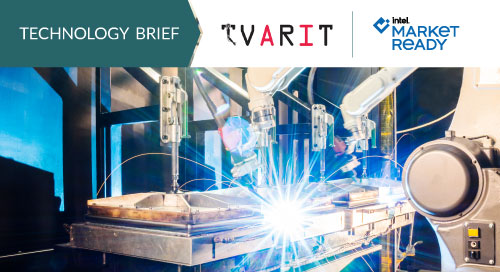AI-Driven Metals Fabrication Leads to Zero Waste

Clearly, no company manufactures products just to send them to a scrap pile, but in the metals casting process, one of five casting components winds up there. While defective metal is recyclable, it takes time and energy to rework. With a lofty goal of zero waste—material, energy, and more—the metal industry is hyper-focused on reducing defects during manufacturing and improving sustainability.
Perhaps the biggest challenge is getting an industry to let go of decades-old practices and embrace the innovative tools and processes of the future—and that starts on the shop floor.
“To get the industrial world to zero waste, it’s important to recognize that 80% of the KPIs (key performance indicators) in manufacturing come from operations,” says Rahul Prajapat, founder of Tvarit GmbH, creator of end-to-end customized AI solutions for manufacturers. “Using AI, we can start to predict the important KPIs, including equipment efficiency, production quality, energy usage, and carbon footprint.”
And these predictions can result in a 20% to 50% reduction in scrap rate and a considerable reduction in energy bills—leading to sustainable and zero-waste manufacturing processes.
Starting from the familiar helps discover what’s possible, by comparing new methods to what companies already have in place. Many use Six Sigma, the long-adopted methodology to define and improve manufacturing quality and processes.
“People on the shop floor use this Six Sigma methodology to achieve required efficiencies,” says Prajapat. “They will start by defining specific types of defects which are occurring in the production line, measure data points on Excel sheets, and do trend analysis. As a result, managers can better understand anomalies and make improvements.”
Based on the following steps, the Tvarit AI-driven quality control system has great overlap with Six Sigma:
- Determine customer readiness by understanding its problem statement and the amount of data available
- Identify the missing measurements and install sensors that can collect additional information
- Prepare an AI approach to predict desired output
- Perform a root cause analysis to find areas of improvement
- Prescribe recommended settings to shop floor engineers
“This overlap gives confidence to shop floor engineers and managers who can go from an old-style improvement that used to gain maybe 1% or 2% reduction in the scrap rate to two-digit improvements that transform their KPIs,” says Prajapat.
#AI predictions can result in a 20% to 50% reduction in scrap rate and a considerable reduction in energy bills—leading to #sustainable and zero waste #manufacturing processes. @TvaritAI via @insightdottech
AI + Domain Knowledge Drive Better Outcomes
But AI alone isn’t a complete solution. A platform like the Tvarit Industrial AI Solution creates a more accurate hybrid model by adding domain knowledge from simulation patterns. These patterns consist of metallurgical knowledge built from an understanding of certain types of defects occurring in products.
The platform is made up of sensors connected to an edge server that sends information through the cloud to the Tvarit AI software that uses predictive modeling, evaluation, and risk analysis.
“Using data from the machine, the production line, and the plant, we can make predictions based on patterns,” says Juergen Halt, research and development director and senior partner of Tvarit GmbH. “When we bring it all together and create a hybrid model, we can simulate situations and make those predictions much more accurate. It’s like having automatic cruise control in a car, but because you now have radar, you don’t crash against the wall.”
The Industrial AI solution includes three components:
- Tvarit Industrial AI (TIA), where specialized pretrained AI modules for metal manufacturing processes are stored, for instance, Aluminum Die-casting.
- Tvarit Intelligent Monitoring (TIM), which calculates KPIs, including machine availability and performance, product quality, energy consumption, and more. It runs on infrastructure powered by Intel® Xeon® servers and cloud platforms such as AWS and Azure.
- Tvarit Observant Module (TOM), a hardware module, which includes edge devices that collect data and mark the component for traceability.
“TIA is our unique selling proposition,” says Prajapat. “It evaluates the data and predicts risk. It’s an end-to-end solution where customers can pick the modules needed for their operation.
Predictive Analytics in Aluminum Casting Reduces Waste
An aluminum casting manufacturer uses the Tvarit AI Solution in its facility to generate real-time visibility that helps improve its scrap rate.
“There are two big challenges with aluminum casting,” says Prajapat. “First, it takes hours or sometimes one or two days to get the results if the coil produced is good or bad. A company can’t do logistics or supply chain planning because it’s lacking real-time visibility. And the second challenge is the scrap rate, which in this industry can range from 6% to 10%.”
Leveraging predictive-analytics AI models, the aluminum manufacturer resolved these challenges using Tvarit’s process-specific AI models for die-casting, welding, and cold forming. The company also used plant-specific customizations that created ease of scale through the transfer learning technology for sensor data analytics.
“The biggest impact was real-time analytics,” says Prajapat. “If there are any defects occurring in the process, they can get those insights in real time. We were able to reduce the defect by 35% for this customer. And this is the impact we are driving for all of our customers in the metal industry.”
“The keys to change are proof of concept and agility,” says Halt. It’s also teamwork with the customer. These are the most important elements for creating positive change.”